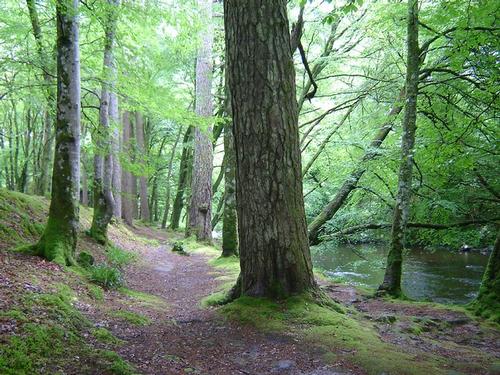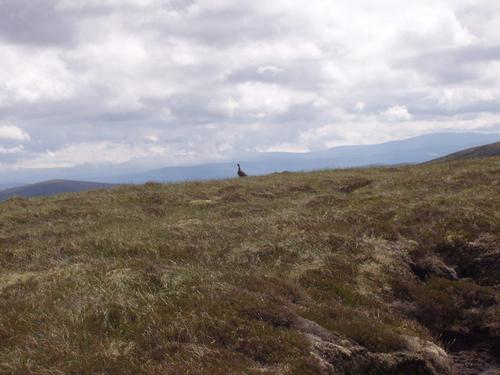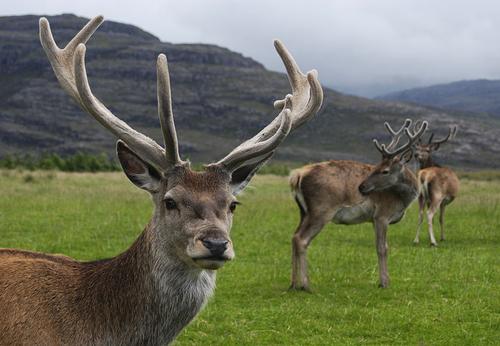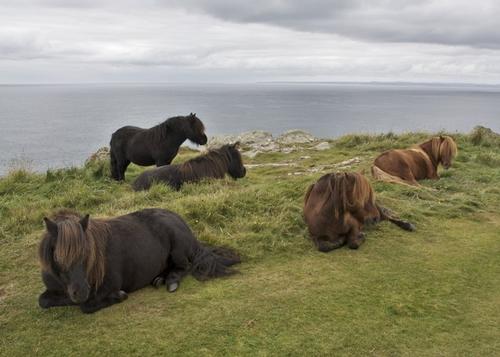SCOTLAND
Plants and Animals

Plants and Animals
Cities in SCOTLAND
| Edinburgh | Glasgow |
Popular destinations UNITED KINGDOM
| England | Northern ireland | Scotland |
| Wales |
Plants and Animals
Plants
In Scotland there are some vegetation types that are characteristic of the Atlantic climate.
 Forests in ScotlandPhoto: Mathieu Bouchard (CC BY 2.0) no changes made
Forests in ScotlandPhoto: Mathieu Bouchard (CC BY 2.0) no changes made
The forests in Scotland are generally deciduous forests. Beech forests are found on the poorer soils and the evergreen yew, holly and rowan are also found here. In the more humid forests we find an undergrowth of wood anemone, bingel herb, bilberry and bracken.
Ash groves are located in western Scotland along the Nevis River and on the mountain slopes. The undergrowth here is much more varied, including hazel, clematis, hawthorn, red dogwood. Forget-me-not, sweet woodruff and the mountain night orchid grow on the bottom.
Birch forests grow in Scotland from sea level to an altitude of 600 meters. The trees are quite far apart.
Coniferous forests are not naturally found in Scotland, so most conifers are planted.
A large part of the Highlands consists of sparse, treeless high plains. About 4,000 years ago, the landscape looked very different; the land was largely covered with native pine trees (Scots pine). These original forests have almost disappeared and instead a four-meter thick layer of bog and peat was created. Natural Scots Pine forests are only found in the central and eastern Highlands. These so-called Caledonian pine forests are often accompanied by mountain ash, downy birch and aspen poplar. The bottom is covered by juniper, common heather, cowberry and tormentil.
Scotland is known for its vast moors, which are maintained by grazing, cutting or burning down the moor. There are different types of heather.
The dry type is found in East Scotland and has fairly enclosed vegetation with heather, red heather, crow heather, bearberry, bilberry and cowberry. The bottom here is covered with mosses and lichens.
 A grouse on the moorland, ScotlandPhoto: Peter Aikman CC 2.0 Generic no changes made
A grouse on the moorland, ScotlandPhoto: Peter Aikman CC 2.0 Generic no changes made
Wet heather is created in nutrient-poor areas, especially in Western Scotland, with heather in particular and some willow, pipe sprout, gale, peat fluff and peat rush.
In areas of wet heather, bogs can easily develop. Where the humus layer gets thicker every year, bedspreads or blanket bogs are created, a thin layer of peat that covers the tops and slopes of hills like a blanket. Among other things, heather leaves, leg break, sphagnum moss, pipe sprout, bud piping, grease leaf and round sundew grow here.
Lens valleys or raised bogs can develop in valleys, with peat bog, cranberry, heather and common heather as the main vegetation. Small pools of herb, water lobelia and water trilium grow in the pools present. Laagveen develops independently of rainwater and arises in valleys.
Scotland's mild climate makes for semi-natural grasslands. The richest grasslands mainly occur in the river valleys, where the soil is neutral and quite moist. The higher the grazing and manure content of cows and sheep, the fewer species there are. These species-poor meadows mainly include: English ryegrass, brassica, rough meadow grass and herbs such as white clover, dandelion, field horn flower and sharp buttercup.
 Yew of Fortingall ScotlandPhoto: Mogens Engelund CC 3.0 Unported no changes made
Yew of Fortingall ScotlandPhoto: Mogens Engelund CC 3.0 Unported no changes made
On the green slope of Mount Ben Lawers in Pertshire at the exit of the Glen Ogle valley is Fortingall Yew, the "yew of Fortingall". The 3000-year-old tree is perhaps the oldest in all of Europe.
The flora of the Scottish Highlands is very varied: over 900 of the 1700 plant species identified in Great Britain are found here. The thistle, the symbol of Scotland and Primula scotia (Scottish primrose) are the best known. Plants have been used to denote the different clans since the Middle Ages. Around 1470, the Scottish kings first chose the thistle as a royal symbol. The pink blooming primrose is only found in Northern Scotland and the Orkney Islands and nowhere else in the world. In areas where snow remains for a long time, only specially adapted flora can survive, such as lady's mantle, sibbaldia and liverwort.
The yellow saxifrage is common in the Arctic, but can also be seen regularly in the Scottish moors.
In the hamlet of Meikleour is a giant beech hedge, which is the highest in the world at about 27 meters. It was planted in 1747 and is still growing.
The small pink Primula scotia is still found on some cliffs of the Orkney Islands.
Animals
 Golden Eagle ScotlandPhoto: Paul Wordingham CC 2.0 Generic no changes made
Golden Eagle ScotlandPhoto: Paul Wordingham CC 2.0 Generic no changes made
Birds of prey
The most impressive appearance, and also a national symbol, is the golden eagle, which is still found on the island of Skye, the Outer Hebrides and the northwestern highlands. In 1985 the white-tailed eagle was released and the osprey and harrier again build nests in Scotland. The peregrine falcon is still common in the Highlands.
Galliformes
In 1770 the capercaillie was released in Scotland, the largest specimen in the family of the shag fowl. The Scottish ptarmigan lives mainly on open heathlands, the black grouse on the heath as well as on the edge of the forest. The Alpine ptarmigan lives high in the mountains.
Seabirds
The Scottish cliffs and islands provide a good habitat for a large number of seabird species, including puffins, guillemots, kittiwakes, razorbills, Northern petrels and gannets.
Mammals
Roe deer are still abundant in the forests, as are foxes, hares and rabbits. Badgers and otters are much less common, while wild cats ("Scottish tiger") and martens can only be found in remote peat and woodlands and ermines only in the north of Scotland. Red squirrels occur in the Highlands, gray squirrels in the Lowlands. Semi-wild animals include Scottish highlanders, Shetland ponies and many sheep species. The snow hare lives on the moors.
Miscellaneous
Only on the islands of Colonsay and Islay are very rare Alpine crows with striking red legs and red beaks.
In the peat bogs of Flow Country in the northern counties of Sutherland and Caithness, rare waders such as the green-legged horseman, merlin, pearl diver and other lapwing, redshank, variegated sandpiper, curlew, diving bird. These animals are threatened by the construction of huge pine and spruce forests.
 Red Deer ScotlandPhoto: Mehmet Karatay CC 3.0 Unported no changes made
Red Deer ScotlandPhoto: Mehmet Karatay CC 3.0 Unported no changes made
The Scottish Highlands is home to some of Scotland's symbols, the golden eagle and the red deer, of which over 300,000 live in the Highlands. Special birds in this area are the capercaillie, corncrake and the endangered marsh ptarmigan. In the mountains and on the 'moors' you will also encounter plenty of fallow deer, roe deer, wild goats, forest cats, weasels, badgers, foxes, hares, rabbits, squirrels and seals and cone seals, dolphins, porpoises, otters and on the coast single whale.
There are about 3,000 pine martens in Britain, all in Scotland.
Until the 12th century there were still plenty of reindeer in Scotland. Mainly due to hunting, they became extinct, but recently a number of herds have been released on the slopes of the Cairngorms.
As for birds, the golden eagle, buzzard, kestrel, sparrow hawk, morel plover, snow bunting and raven are found in the mountains. On the moors we find the peregrine falcon, hen harrier, squeaker, skylark and black grouse. In the coniferous forests you can find many seed eaters such as crossbill, finch and redpoll; gray flycatcher and collared redstart live on insects from the forest. On the coast, waterfowl are strongly represented, including guillemots, razorbills, petrels, kittiwakes, crested cormorants, puffins and arctic terns. Different types of geese, swans and ducks are among the overwinterers. Scotland still has a number of fairly clean salmon rivers.
 Shedland Pony Herd, ScotlandPhoto: Paul Buckingham (CC BY-SA 2.0) no changes made
Shedland Pony Herd, ScotlandPhoto: Paul Buckingham (CC BY-SA 2.0) no changes made
The Shetland Islands are home to eight times as many sheep as humans, but the islands are best known for their Shetland ponies. Because the islands have few forests, there are no more than fifty nesting species of birds, such as gannets, herring gulls, black guillemots, great skua or "bonxies", northern petrels and puffins. On a boat trip around the islands there is a great chance to encounter seals, dolphins and porpoises.
More than 200 species of algae have been found around the Orkney Islands, including microscopic algae; sea cucumber is one of them and furthermore worth mentioning the snail blue gibulla, brittle star, large North sea crab, swimming crab, cockle and blue lobster. A lot of fish swim between and above the undersea seaweeds: herring, salmon, cod, mackerel, sandeel, goby, flatfish and red gurnard. Otters and seals are quite common, especially the gray seal. The most common large whale on Orkney is the pilot whale. With a bit of luck you can also encounter killer whales, common whales and minke whales. The white-beaked dolphin is the most common dolphin-like; the gray dolphin (also called Risso's dolphin) and the white-sided dolphin can also be seen regularly. The bottlenose dolphin and common dolphin are rare.
The national 'animal' of Scotland is the mythical unicorn.
Sources
Berkien, G. / Schotland
Kosmos-Z&K
Berkien, G. / Schotland
ANWB
Larrimore, D. / Schotland
Kosmos-Z&K
Levy, P. / Scotland
Marshall Cavendish
Patitz, A. / Schotland
Van Reemst
Schaff, B. / Schotland
Kok Lyra
Schotland
Cambium
Schotland
Lannoo
Schotland
Michelin Reisuitgaven
Schotland
Van Reemst
Smallman, T. / Scotland
Lonely Planet
Stoks, F.T. / Schotland
Gottmer
Summers, G. / Schotland
Van Reemst
Tschirner, S. / Schotland
ANWB
Wamel, D. van / Schotland en Noord-Engeland
Babylon-De Geus
CIA - World Factbook
BBC - Country Profiles
Last updated December 2025Copyright: Team The World of Info